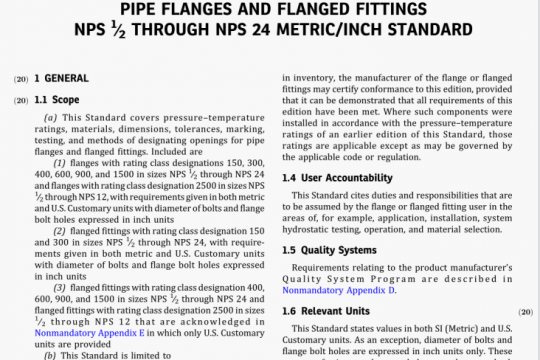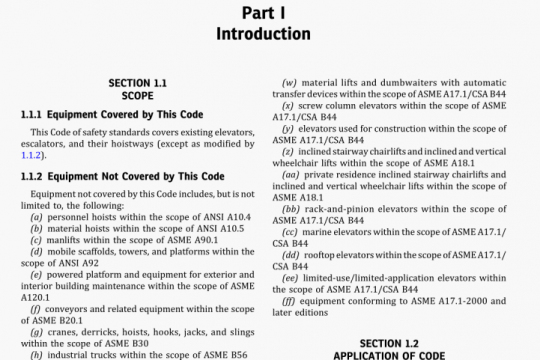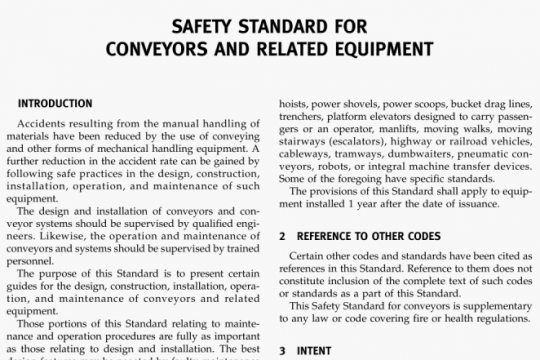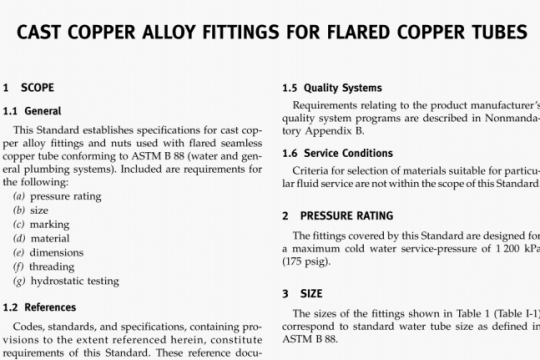ASME SA370-2015 pdf free
ASME SA370-2015 pdf free.TEST METHODS AND DEFINITIONS FOR MECHANICAL TESTING OF STEEL PRODUCTS.
7.1 Loading Svstem. — There are two general types of loading systems, mechanical (screw power) and hydraulic. These differ chiefly in the variability of the rate of load application. The older screw power machines are limited to a small number of fixed free running cmsshead speeds. Some modern screw power machines. and all hydraulic machines permit stepless variation throughout the range of speeds.
7.2 The tension testing machine shall be maintained in good operating condition, used only in the proper loading range. and calibrated periodically in accordance with the latest revision of Practices E 4.
NOTE I — Many machines arc equipped with stress-strain recorders for autogr-aphic pksting of 4te%%-slrain curses, h should he noted that some revorders have a load measuring component entirely separate from the load i dicator of the testing machine. Such recorders are calibrated separately.
7.3 Loading — It is the function of the gripping or holding device of the testing machine to transmit the load from the heads of the machine to the specimen under test. The essential requirement is that the load shall be transmitted axially. This implies that the centers of the action of the grips shall be in alignment, insofar as practicable. with the axis of the specimen at the beginning and during the test and thai bending or twisting be held to a mini,num. For specimens with a reduced section. gripping of the specimen shall be restricted to the grip section. In the case of certain sections tested in full size, nonaxial loading is unavoidable and in such cases shall he permissible.
7.4 Speed of Testing — The speed of testing shall not be greater than that at which load and strain readings can be made accurately. In production testing. speed of testing is commonly expressed: (I) in terms of free running cross- head speed (rate of movement of the crosshead of the testing machine when not under load). (2) in terms of rate of separation of the two heads of the testing machine under load. (3) in ternis of rate of stressing the specimen. or (4) in terms of rate of straining the specimen. The following limitations on the speed of testing are recommended as adequate for most steel products:
NOTE 2 — Tension tests u%ng elosed.lonp ,nactiines (with feedback control of rate) should not be perfonned using load control, as this mode of testing will rcsutt in acceleration of the crosshead upon yielding and elesation of the measured yield strength.
7.4.1Any convenient speed of testing may be used up to one half the specified yield point or yield strength.
When this point is reached, the free-running rate of separalion of the crossheads shall be adjusted so as not to exceed 46 in. per mm per inch of reduced section. or the distance between the grips for test specimens not having reduced sections This speed shall he maintained through the yield point or yield strength. In determining the tensile strength. the free-running rate of separation of the heads shall not cxcccd !- in. per mm per inch of reduced section. or the distance between the grips for test specimens not having reduced sections. In any event, the minimum speed of testing shall not be less than the specified maximum rates for determining yield point or yield strength and tensile strength.
7.4.2 It shall he permisxihle to set the speed of the testing machine by adjusting the free running crosshcad speed to the above specified values, inasmuch as the rate of separation of heads under load at these machine settings is less than the specified values of free running crosshcad speed.
7.4.3 As an alternative, if the machine is equipped with a device to indicate the rate of loading, the speed of the machine from half the specified yield point or yield strength through the yield point or yield strength may be adjusted so that the rate of stressing does not exceed 100 (XX) psi (690 MPa/min. However, the minimum rate of stressing shall not be less than 10 (XX) psi (70 MPaVtnin.
8. Test Spednwii Parameters
8.1 Selection Test coupons shall be selected in accordance with the applicable product specifications,
8.1.1 Wrought Steels — Wrought steel products are usually tested in the longitudinal direction, hut in some cases, where size permits and the service justifies it. testing is in the transverse, radial, or tangential directions (sec Fig. I and Fig. 2.
8.1.2 Forged SseeLc — For open die forgings, the metal for tension testing is usually provided by allowing extensions or piolnngations on one or both enth of the forgings, either on all or a representative number as provided by the applicable product specifications. Test specimens are normally taken at mid-radius. Certain product specifications permit the use of a representative bar or the destruction of a production part for test purposes. For ring or disk-like forgings test metal is provided by increasing the diameter, thickness, or length of the forging. Upset
disk or ring forgings, which are worked or extended by forging in a direction perpendicular to the axis of the forging, usually have their principal extension along concentric circles and for such forgings tangential tension specimens are obtained from extra metal on the periphery or end of the forging. For some forgings, such as rotors, radial ten- sion tests are required. In such cases the specimens are cut or trepanned from specified locations.ASME SA370 pdf free download.




